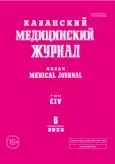Evaluation of osteopathic treatment effectiveness in patients with upper thoracic aperture syndrome
- Authors: Egorova I.A.1,2, Dyupin A.V.1,2, Danisko R.S.3, Chervotok A.E.1,2
-
Affiliations:
- Novgorod State University named after Yaroslav the Wise
- Institute of Osteopathic Medicine named after V.L. Andrianov
- Motus Medical Centre
- Issue: Vol 104, No 6 (2023)
- Pages: 828-834
- Section: Theoretical and clinical medicine
- URL: https://journals.rcsi.science/kazanmedj/article/view/257263
- DOI: https://doi.org/10.17816/KMJ568769
- ID: 257263
Cite item
Abstract
Background. Upper thoracic aperture syndrome occurs in 2–8% of people in the population and affects patients of the most working age, mainly women.
Aim. Evaluation of the combined (drug + osteopathic) treatment effectiveness of patients with upper thoracic aperture syndrome compared to drug therapy.
Material and methods. In a randomized study, patients with signs of upper thoracic aperture syndrome were divided into two groups: the main group received combined (osteopathic + drug) treatment for 2 months; the control group received only drug treatment (non-steroidal anti-inflammatory drugs, muscle relaxants, thioctic acid preparations) for 2 months. Each group consisted of 15 women aged from 25 to 47 years (main group — 36.31±7.33 years, control group — 35.18±6.76 years), the duration of the disease ranged from 6 to 18 months (main group — 12.02±3.57 months, control group — 11.07±3.97 months). The groups were comparable in age composition and duration of the disease. To assess the effectiveness of the treatment, the dynamics of symptoms of neuropathic pain, stimulation electroneuromyography, and the dynamics of osteopathic status indicators were used. Data were presented as arithmetic mean and standard deviation. When analyzing intergroup differences, the nonparametric Mann–Whitney test (U-test), and when analyzing intragroup differences, the nonparametric Wilcoxon test (W-test) were used. The statistical significance of the difference in the frequency of osteopathic dysfunctions and other frequency parameters before and after treatment was assessed using the Pearson χ2 test. The critical level of statistical significance was taken as 5% (p=0.05).
Results. The combination of osteopathic and drug treatment led to a difference in conduction along the right ulnar nerve between groups (p=0.0003) in the main group — an increase in speed from 48.1±1.54 m/s to 61.0±3.34 m/s (p=0.0007), in the control group — from 46.8±1.89 m/s to 50.2±4.85 m/s (p=0.0009). Analysis of the NTTSS-9 scale (assessment of symptoms of neuropathic pain) after treatment showed no difference between the groups (p=0.0941): the main group — before treatment 14±2.14 points, after treatment 2±1.4 points (p =0.0003), control group — before treatment 15±1.95 points, after treatment 6±2.80 points (p=0.0007).
Conclusion. In the group that received combined (osteopathic + drug treatment), a greater increase in conductivity along the ulnar nerve was found.
Full Text
##article.viewOnOriginalSite##About the authors
Irina A. Egorova
Novgorod State University named after Yaroslav the Wise; Institute of Osteopathic Medicine named after V.L. Andrianov
Author for correspondence.
Email: egorova.osteo@gmail.com
ORCID iD: 0000-0003-3615-7635
SPIN-code: 8356-2615
Scopus Author ID: 56542966000
ResearcherId: AAQ-1290-2021
M.D., D. Sci. (Med.), Prof., Head of Depart., Depart. of Restorative Medicine and Osteopathy; Director
Russian Federation, Veliky Novgorod, Russia; St. Petersburg, RussiaArtem V. Dyupin
Novgorod State University named after Yaroslav the Wise; Institute of Osteopathic Medicine named after V.L. Andrianov
Email: adyupin@mail.ru
ORCID iD: 0000-0002-5881-2314
Assistant, Depart. of Restorative Medicine and Osteopathy; Lecturer
Russian Federation, Veliky Novgorod, Russia; St. Petersburg, RussiaRoman S. Danisko
Motus Medical Centre
Email: da.r@bk.ru
ORCID iD: 0009-0005-8689-6294
M.D.
Russian Federation, Yaroslavl, RussiaAndrey E. Chervotok
Novgorod State University named after Yaroslav the Wise; Institute of Osteopathic Medicine named after V.L. Andrianov
Email: andro-med@rambler.ru
ORCID iD: 0000-0002-8559-982X
M.D., Cand. Sci. (Med.), Assoc. Prof., Head of Depart., Depart. of Restorative Medicine and Osteopathy; Deputy Director for Educational Work
Russian Federation, Veliky Novgorod, Russia; St. Petersburg, RussiaReferences
- Kharchenko VV, Loseva VA. Upper chest aperture syndrome. Integrativnye tendentsii v meditsine i obrazovanii. 2022;4:240–244. (In Russ.)
- Kutsai NV, Golovina ER, Adzhisaliev GR. Modern methods of treatment of upper thoracic aperture syndrome. Innovatsii. Nauka. Obrazovanie. 2020;(24):1933–1939. (In Russ.)
- Gaibov AD, Sultanov DD, Rakhmonov DA, Nematzoda O, Zugurov AKh, Kalmykov EL. Results of treatment of thoracic outlet syndrome followed by vascular complications. Russian journal of cardiology and cardiovascular surgery. 2018;11(6):52–57. (In Russ.) doi: 10.17116/kardio20181106152.
- Muin R, Magomedov RK, Tsuladze II. Clinical diagnostic features of surgical treatment for thoracic outlet syndrome. Burdenko’s journal of neurosurgery. 2015;79(2):55–63. (In Russ. doi: 10.17116/neiro201579255-63.
- Collins E, Orpin M. Physical therapy management of neurogenic thoracic outlet syndrome. Thorac Surg Clin. 2021;31(1):61–69. doi: 10.1016/j.thorsurg.2020.09.003.
- Panther EJ, Reintgen CD, Cueto RJ, Hao KA, Chim H, King JJ. Thoracic outlet syndrome: A review. J Shoulder Elbow Surg. 2022;31(11):545–561. doi: 10.1016/j.jse.2022.06.026.
- Jones MR, Prabhakar A, Viswanath O, Urits I, Green JB, Kendrick JB, Brunk AJ, Eng MR, Orhurhu V, Cornett EM, Kaye AD. Thoracic outlet syndrome: A comprehensive review of pathophysiology, diagnosis, and treatment. Pain Ther. 2019;8(1):5–18. doi: 10.1007/s40122-019-0124-2.
- Sanders RJ, Hammond SL, Rao NM. Diagnosis of thoracic outlet syndrome. J Vasc Surg. 2007;46(3):601–604. doi: 10.1016/j.jvs.2007.04.050.
- Balderman J, Abuirqeba AA, Eichaker L, Pate C, Earley JA, Bottros MM, Jayarajan SN, Thompson RW. Physical therapy management, surgical treatment, and patient-reported outcomes measures in a prospective observational cohort of patients with neurogenic thoracic outlet syndrome. J Vasc Surg. 2019;70(3):832–841. doi: 10.1016/j.jvs.2018.12.027.
- Warrick A, Davis B. Neurogenic thoracic outlet syndrome in athletes — nonsurgical treatment options. Curr Sports Med Rep. 2021;20(6):319–326. doi: 10.1249/JSR.0000000000000854.
- Cavanna A, Giovanis A, Daley A, Feminella R, Chipman R, Onyeukwu V. Thoracic outlet syndrome: A review for the primary care provider. J Osteopath Med. 2022;122(11):587–599. doi: 10.1515/jom-2021-0276.
- Patel K, Horak HA. Electrodiagnosis of common mononeuropathies: Median, ulnar, and fibular (peroneal) neuropathies. Neurol Clin. 2021;39(4):939–955. doi: 10.1016/j.ncl.2021.06.004.
- Osteopatiya v razdelakh. Chast’ II. Rukovodstvo dlya vrachey. (Osteopathy in sections. Part II. A guide for doctors.) IA Egorova, editor. Saint-Petersburg: SPbMAPO; 2017. 224 p. (In Russ.)
- Osteopatiya v razdelakh. Chast’ III. Rukovodstvo dlya vrachey. (Osteopathy in sections. Part III. A guide for doctors.) IA Egorova, editor. Saint-Petersburg: SPbMAPO; 2014. 206 p. (In Russ.)
Supplementary files





